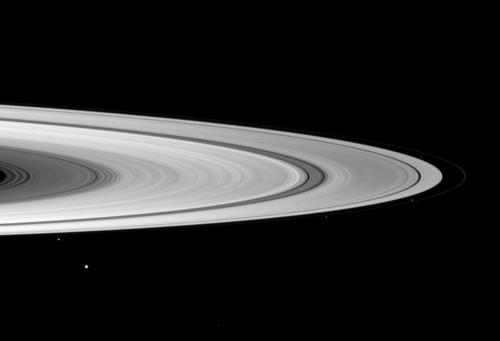[/caption]
In a move reminiscent of Star Trek’s Scotty fine-tuning the Enterprise’s performance, engineers working with the Cassini spacecraft will begin work to switch the spacecraft’s thrusters to a back-up set after noticing a degradation in performance from the main thrusters that have been in use for over 11 years, since the spacecraft launched in October of 1997. The thrusters are used for making small corrections to the spacecraft’s course and for attitude control. In mid-March, the current set of eight thrusters, referred to as branch A, will be swapped over to a redundant and identical set, branch B. In a forward thinking move, almost all Cassini engineering subsystems have redundant backup capability. And in a testament of the spacecraft’s robustness and reliability, this is only the second time during Cassini’s 11-year flight that the engineering teams have gone to a backup system.
“Ay, Captain. Auxiliary thrusters engaged!”
Cassini’s propulsion engineers began to see a lower performance from one of the thrusters on branch A in October, and recently a second branch A thruster also began now showing some degraded performance.
An extensive review with the propulsion system contractor, Lockheed Martin Space Systems, Denver, Colo., the thruster manufacturer, Aerojet, Sacramento, Calif., and propulsion experts at NASA’s Jet Propulsion Laboratory, Pasadena, Calif., was completed last week. The recommendation was made to swap to side B as soon as is practical.

Mid-March is the earliest practical opportunity to make the swap. This allows time for the team to properly test and prepare the sequence of commands that will be sent to the spacecraft. Science planners have identified a period where no high-priority science will be lost during the switch, which will be done over a seven-day window. It also is a time when no navigation maneuvers are required to maintain the spacecraft’s trajectory.
The swap involves commanding a latch valve to open hydrazine flow to the B side, and powering on some thruster control electronics. No pyrotechnic devices are involved in the swap, and the action is fully reversible if necessary.
A few years ago, the backup reaction wheel was brought online and is currently functioning as one of the three prime wheels.
Cassini successfully completed its four-year planned tour and is now in its “Equinox” extended mission operations.
Source: JPL


amazing really when you sit and think on it
Hope all goes well for the Lady.
An amazing spacecraft, extremely well engineered.